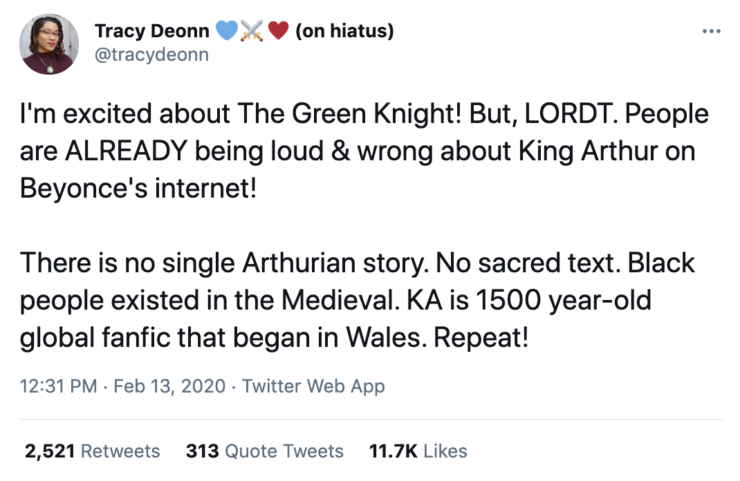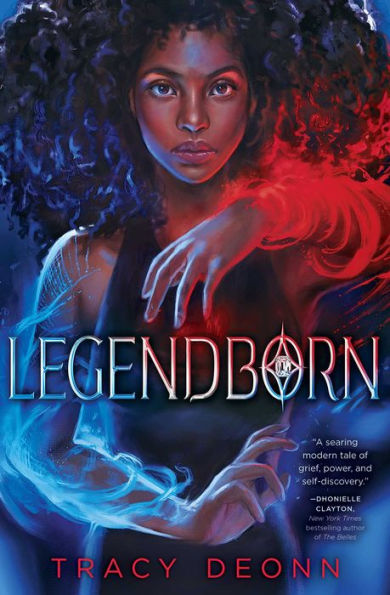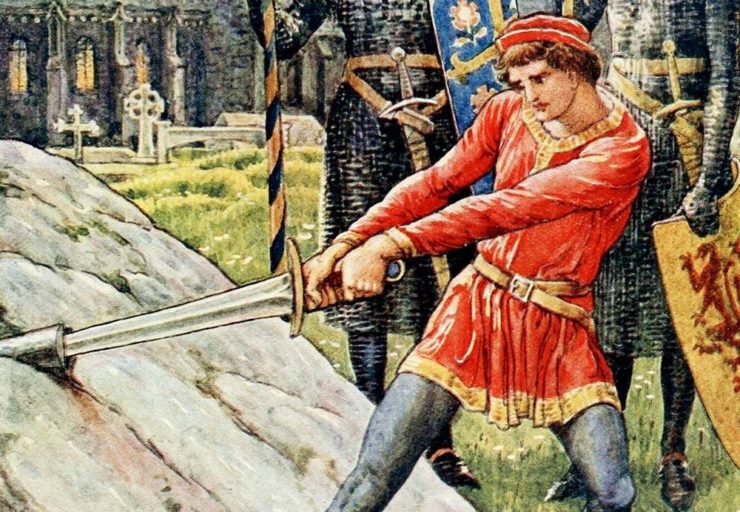King Arthur stories are experiencing a recent resurgence in popular media, with The Green Knight starring Dev Patel announced in 2020, Cursed on Netflix, and several new Arthur-inspired books on shelves and on the horizon. Like clockwork, with each announcement of a new Arthurian tale, there come inevitable calls for “authenticity.” Within hours of the trailer for The Green Knight dropping last year, people took to Twitter to discuss the significance of Patel’s casting, and plenty of commenters began asserting that Patel’s inclusion was ahistoric, even though people of color existed and participated in the world of the medieval era. They claimed the film was not “true” to the legend.
I reflexively tweeted the following, having been deeply embedded in my own King Arthur research at the time:

Arthurian stories originated in Wales, but for the modern audience the body of work we call Arthuriana is not drawn from a single reference point. These calls for authenticity are framed as though Arthuriana has a pure, original state to which we as storytellers can and should return. It does not. They suggest that the canon of King Arthur legends includes one single, universally accepted, historically accurate narrative. It does not. Not only are these calls for a single true Arthur story themselves ahistoric, but they ignore hundreds of years of Arthurian storytelling tradition–a tradition that has always included remixes and reinventions.
Why is it important to me to call Arthuriana fanfic? Because doing so reframes these stories as shared, flexible narratives. Calling it fanfic loosens the grip of ownership that the myth of a single story perpetuates. (We’ll get to who benefits from that claim to ownership in a moment.)
When you hear the phrase, “the legend of King Arthur” what images appear in your mind? Do you see Arthur first, a noble man in shining armor? Excalibur in its stone? Do you think of the Round Table? The Holy Grail? What would you say if I told you that your constructed list of Arthurian mental images both belongs to you and to someone else, is both true and false, is both complete and incomplete? Because this “both-and” paradox is the very nature of King Arthur.
Let me clarify: I don’t mean the historic Arthur, if he ever existed. Or even the specific Arthur character in a given piece of literature or media. I mean the imagined Arthur, and the narrative network of Arthuriana that has been woven around him over the past 1500 years. The one that lives in our collective modern minds in story bites and flashes of imagery. The one we stitch together from TV shows and children’s books and adult novels and, yes, The Sword in the Stone Disney movie. This Arthur resists a single story as a matter of course, making him the perfect epicenter for inclusive reimaginings, reinterpretations, and remixes—and a confusing, if not futile, site for retellings.
If you ask a medievalist to tell you the King Arthur story, they will bemusedly ask, “Which one?” If you ask them to list the roster of knights at the Round Table, they will say “Whose list?” Some stories claim there were 150 knights, some claim twelve. I witnessed varying levels of this academic response over two years while consulting with experts on Legendborn. There is no agreed-upon canon to point to, cling to, or worship. There is only a collection of literature, stories, settings, characters, magical objects, and circumstances that contribute to the massive world of Arthuriana.
My Arthurian reimagining did not begin with King Arthur. It began with grief.
When my mother passed away, I learned that she had lost her mother at the same age that I lost her, and that the same had occurred with my grandmother and great-grandmother–a strange pattern with no explanation. I wondered, why would this pattern of death exist in my family? Of course, there is no answer here, but I’m a writer raised on science fiction and fantasy, so I wrote a magical answer to an impossible question. Legendborn began from a place of grief and mystery, the same place in which my main character, a sixteen year-old girl named Bree, begins in the prologue to the book.
Buy the Book


Legendborn
I needed to explore the idea of legacy through an epic, modern fantasy because a mystery this big deserved a journey that expansive, and because I had never seen a novel like that with a Black teenage girl at the center.
Like me, Bree is the most recent daughter in a line of Black women whose deaths came early. Like me, and so many other Black Americans, as she explores her family history, she eventually comes up against the wall of enslavement—the wall where the answers stop, weren’t recorded, and were stripped away. At this point, the question changed. Instead of “Why does this pattern exist?” it became, “Whose lives and losses get forgotten or erased, and whose lives and losses become legendary?” That is when Arthur appeared, as a collective legend about a man who may not have ever existed, but whose stories have survived centuries. Arthurian legends explore the same themes I wanted to examine in my contemporary fantasy novel: legacy, power, family, and the responsibilities laid before each generation when the previous generation dies.
North Carolina became the setting of my reimagined Arthurian tale, because growing up in the South, the question of whose lives we memorialize is in the air we breathe. From statues to memorials to names of streets and buildings, I learned very early that the creation of public memory is a privilege locked tight in white and Western hands. When Bree’s search for the truth about her mother’s death leads her to an Arthurian secret society, I intentionally use her experiences as a Black teenage girl in the South to interrogate and refresh King Arthur and the legends, both in her world and ours. While I anchor my Arthur in Wales, I use magic to explain how the Round Table could still be in existence in Bree’s modern day. If I described Legendborn in fanfic language, I’d call it a canon-divergent Arthurian alternate universe (or AU) set in the real world with an original character, or OC. And I wouldn’t be the first to write this way.
Fanfic is the Tradition
Before legal and financial structures around story came into being, before printing and distribution, the idea of “owning” a story probably seemed very silly. A story was something shared from person to person and mouth-to-ear, from one speaker sitting around a campfire to a group of eager listeners. Stories are flexible, living things, while works have defined boundaries: page counts, run-times, first and second editions. And alongside these boundaries come the broader structures of copyright, intellectual property, ownership, and canon.
As a lifelong fangirl who has been immersed in Arthuriana for the past several years, now I see these stories as branching pathways and intentional games of telephone. And the writers generating these stories worked much like fanfic authors, using an existing story structure and cast of characters, but telling the story from an alternate perspective to explore a new idea. Or lifting a cast of characters wholesale and placing them in a new plot to better examine relationships. This transformative approach is in the genetic make-up of King Arthur. In fact, rewriting King Arthur from new cultural, national, and experiential perspectives is the tradition.
Geoffrey of Monmouth’s Historia regum Britanniae, or “The History of the Kings of Britain,” crafted many of the now familiar Arthurian elements, but he built them on top of and alongside previously existing details and stories. In other words, Monmouth’s Historia is a massively influential piece of 12th century fanfic.
In the 21st century, Lancelot du Lac, arguably the most famous knight of Arthur’s Table, is presented as an ever-present, essential figure and first knight. But this version of Lancelot was crafted by poet Chrétien de Troyes in the 12th century as an addition to Arthuriana, six hundred years after the first written mention of Arthur. This Lancelot, in fic-speak, is an OC; an Original Character the author added to the existing cast. I look at the Lancelot-Grail Cycle and see a long series of “missing scenes” and shipper fics.
The tale of the sword in the stone and Arthur pulling the blade to prove his right to be king is from 13th century French poet Robert de Boron, rewriting portions of Monmouth to weave a new work that also included a heavy emphasis on the wizard Merlin. When Thomas Malory took on the legends in 15th century England, he used pre-existing characters to write a sweeping canon-divergent, romance-heavy, epic AU series. He called this series Le Morte d’Arthur, and it became one of the most cited “sources” for Arthurian legends.
Each of these authors in history was writing in his own specific cultural and political context, and the new additions and changes they made were created from and for these contexts. Each new contribution was, as my friend and Arthurian scholar Bezi Yohannes says, “an act of political imagination.” A declaration of values and a prioritization of some characters over others. These authors were deliberately weaving into Arthuriana—one of the most iconic collections of legends we have—the type of representation that they wanted to see, and we cannot separate their identities and perspectives from their creations.
This borrowing and building story process didn’t stop with these writers. Authors and screenwriters still pull the canon of Arthuriana open like a drawer and select the components they most want to utilize without restrictive concern for whether their portrayals are “accurate” to previous ones. And it’s time we take a hard look at whose “inaccurate” storytelling gets privileged as “accurate,” and why.
In a domain of fanfic based on other fanfic, written by countless people across centuries, cultures, and languages without prior permission or citation—claiming which stories are real and which aren’t is also a political act.
If one were to look only back to the dominant Arthurian texts and movies, extremely white, cis, straight, and male dominated narratives are the outcome, often in gritty, medieval-esque settings. But those types of retellings are a symptom of canon-dependency, when freedom from canon is how Arthur has survived this long in the first place. This is why Arthurian retellings are so powerful, after all—because we are watching characters in the midst of epic, legendary lives, who have the potential to be remembered long after they’re gone
When Arthurian retellings like The Green Knight, or other stories with inclusive representations of race, gender, sexuality, and other identities, are deemed “inauthentic,” these claims aren’t based on Arthuriana’s reality. They’re based on exclusion. When someone declares one story the “true” and another one “false,” in an example as egregious as King Arthur, the declaration must be interrogated. When a narrative landscape has no central and true text, an effort to delegitimize certain versions becomes a tool of oppression that polices who gets to tell which stories, and who gets to have adventures at an Arthurian scale. Simply put, marking new and diverse additions to Arthuriana as either fact or fiction is a way to limit who gets to be legendary–and whose challenges and triumphs are worthy of remembrance.
Tracy Deonn is the New York Times bestselling and Coretta Scott King-John Steptoe Award winning author of Legendborn, and a second-generation fangirl. She grew up in central North Carolina, where she devoured fantasy books and Southern food in equal measure. After earning her bachelor’s and master’s degrees in communication and performance studies from the University of North Carolina at Chapel Hill, Tracy worked in live theater, video game production, and K–12 education. When she’s not writing, Tracy speaks on panels at science fiction and fantasy conventions, reads fanfic, arranges puppy playdates, and keeps an eye out for ginger-flavored everything.










